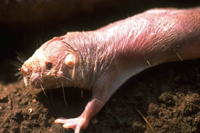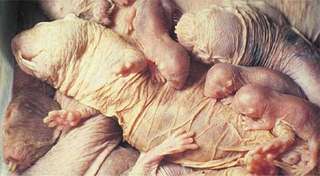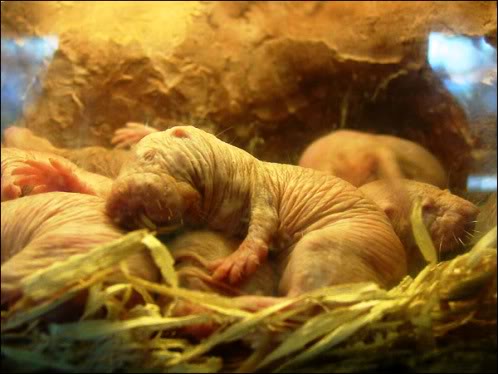 Eusociality in Naked Mole-Rats
Eusociality in Naked Mole-Rats
Biology 342 - Fall 2010
Isabel Cylinder & Quinn Amacher
Ontogeny
What is Ontogeny?
In contrast to phylogeny, which refers to the changes which take place in a species over time, ontogeny refers to the changes undergone by a single organism within its lifetime (20). The ontogeny of naked mole-rat eusociality, then, can be redefined as the changes undergone in the lifetime of a single naked mole-rat with respect to its behavior as a member of a eusocial colony.
Infancy

Naked mole-rat pups are cared for primarily by members of the working caste. In addition to being fed, pups also beg feces from members of all castes within the colony (12). By rolling themselves in these collected feces, the pups become marked with the colony odor, a scent that must be very frequently reinforced if they are to continue to be identified as fellow colony members (14,19). From birth, pups are vigorously shoved around the nest chamber, primarily by their mother and father, but with the participation of the colony entire. Such shoving peaks three to four weeks into pup development and is believed to be essential to the integration of pups into the larger social hierarchy (14).
Within one to two months of pup development, the pup joins the frequent worker caste and eventually grows to the mean frequent worker size once it is more than one year old (12). From here, however, the pup’s behavioral development can vary.
Pictured: Naked mole-rat pups nursing. (C)
Caste Development
 As a frequent worker, the mole-rat will perform the majority of colony maintenance and pup care. It will also be of a smaller body size than a member of the colony’s other castes (12,14). At another point in its development, the mole-rat will join the infrequent worker caste. Infrequent workers are usually older and larger and contribute less to the tasks of foraging and nest building. Their body size and large incisors, however, allow infrequent workers to function as the colony’s main defense force. When naked mole-rats form a chain to empty excess dirt to the surface, the mole-rat closest to the surface (the “volcanoer,” so-called because his kicking of dirt resembles a volcano in miniature) is often a larger and older member of the colony (8,14).
As a frequent worker, the mole-rat will perform the majority of colony maintenance and pup care. It will also be of a smaller body size than a member of the colony’s other castes (12,14). At another point in its development, the mole-rat will join the infrequent worker caste. Infrequent workers are usually older and larger and contribute less to the tasks of foraging and nest building. Their body size and large incisors, however, allow infrequent workers to function as the colony’s main defense force. When naked mole-rats form a chain to empty excess dirt to the surface, the mole-rat closest to the surface (the “volcanoer,” so-called because his kicking of dirt resembles a volcano in miniature) is often a larger and older member of the colony (8,14).
Though individual members of the colony tend to grow larger with age, and thus to move from the frequent to the infrequent worker caste, the speed of this change can vary between litters and even between pups, with some mole-rats remaining permanently within the frequent worker caste (12). Mole-rats have been observed to grow faster in incipient colonies than in well-established ones, suggesting that social pressure upon the individual to fulfill needed, defensive roles within the colony has an effect upon its growth and, therefore, its behavior (14).
Pictured: Naked mole-rat pup sleeping. (D)
Reproductive Roles
The non-breeding members of the colony are not sterile, but their ability to breed is suppressed through the aggression of the breeding queen (5,6,11,14). Some experiments have shown as a result of the queen’s removal an increase in progesterone levels in females and in testosterone levels in males (5). Following the death of a queen, the largest non-working females of the colony soon begin ovulating (14). These sexually mature females will then fight, often to the death, for the position of queen (5,8,14). The successive breeding males are determined not through competition but through female mate choice, with the new queen occasionally retaining the breeders of the old regime (14). Though all naked mole-rats are born of a queen, it is only a very few that will one day themselves ascend to the role of a central, breeding tyrant.
Pictured: A female naked-mole rat. (E)